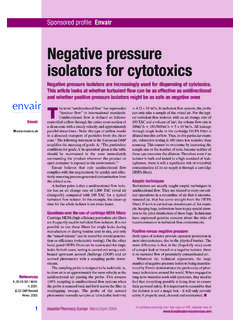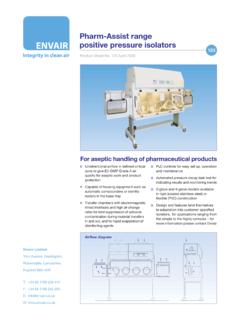Transcription of BIO 2+ - Home | Envair
1 bio 2 +. DRS. DB2. RRS. RD. Fumigation Options D. R. Integral Formalin Vapouriser with auto timer O O S. Integral Formalin Vapouriser with auto timer and exhaust sealing valve O S O. Auto-purge to allow full automatic fumigation cycle O O S O S O. 5m fumigant extract flexible duct including connection O S. Mobile carbon filter unit O O. H202 vapour phase biodecontamination system including connections and sealing valves O O O O O O. Note: When a formalin vaporiser is fitted to a recirculating (R or RRS) cabinet, it must be used either in conjunction with the 5m fumigant extract flexible duct including connection (if there is a window or fume cupboard nearby through which it can exhaust) or with the Mobile carbon filter unit. Useful Information - Definitions BS EN 12469 2000 ACDP (Advisory Committee for Dangerous Pathogens).
2 Microbiological safety cabinet (MSC): Ventilated enclosure intended to offer protection to the user and the environment from Hazard Group 1: A biological agent unlikely to cause disease. the aerosols arising from the handling of potentially hazardous and hazardous micro-organisms, with air discharged to the atmosphere being filtered. MSC Class I: Safety cabinet with a front aperture through which Hazard Group 2: A biological agent that can cause human disease the operator can carry out manipulations inside the cabinet and and may be a hazard to employees; it is unlikely to spread to the which is constructed so the worker is protected and the escape of community and there is usually effective prophylaxis or effective airborne particulate contamination generated within the cabinet is treatment available.
3 Controlled by means of an inward airflow through the working front aperture and filtration of the exhaust air. MSC Class II: Safety cabinet with a front aperture through which the operator can carry out manipulations inside the cabinet and which is constructed so the worker is protected, the risk of Hazard Group 3: A biological agent that can cause severe human product and cross contamination is low and the escape of airborne disease and presents a serious risk to employees; it may present a particulate contamination generated within the cabinet is controlled risk of spreading to the community, but there is usually effective by means of an appropriate filtered internal airflow and filtration of prophylaxis or treatment available. the exhaust air. NOTE A typical way of achieving this is by means of a unidirectional downward laminar airflow inside the cabinet and an air curtain at the front aperture.
4 MSC Class III: Safety cabinet in which the working area Hazard Group 4: A biological agent that causes severe human is totally enclosed and the operator is separated from the work disease and is a serious hazard to employees; it is likely to spread by a physical barrier ( gloves mechanically attached to the to the community and there is usually no effective prophylaxis or cabinet). Filtered air is continuously applied to the cabinet and the treatment available. exhaust air is treated to prevent release of micro-organisms. Essential reading: Advisory Committee on Dangerous Pathogens: The management, design and operation of microbiological containment laboratories, HSE. Books, 2001. Envair Product Sheet 102. York Avenue April 2006. Haslingden Rossendale Lancashire BB4 4HX.
5 United Kingdom T: +44 (0) 1706 228 416. F: +44 (0) 1706 242 205. email: website: CLASS II MICROBIOLOGICAL SAFETY CABINET - bio 2 +. Compact, highly specified, high performance Class II microbiological safety cabinets with unique double HEPA filtration. Applications Cell culture operations and handling of biological agents up to Hazard Group 3* where both retention efficiency (operator protection) and the provision of clean air conditions over the work area are required as well as total compliance with all the requirements of BS EN 12469: 2000. * ACDP Categorisation Benefits Carefully designed and extensively tested to provide assurance of microbiological safety when used with biological agents up to ACDP Hazard Group 3 (subject to proper siting, operation and maintenance).
6 Unique double HEPA filtration system and many other design features to facilitate safe and easy operation, cleaning, testing and maintenance Aerodynamically independent downflow and exhaust air fan systems to facilitate quick and easy set up Wide range of sizes, configurations and fumigation options to provide a solution for every laboratory and application Standards Compliance BS EN 12469: 2000. Certified by CAMR (now HPA) at Porton Down All HEPA filters H14 to BS EN 1822-1: 1998. IEC 61010-1: 2001. Installation to BS 5726: 2005 is recommended Air quality to ISO Class 5 (BS EN ISO 14644-1: 1999) and EC. GMP Grade A for a high level of product protection Principal Design Features Unique double HEPA filtration system comprising a primary (exhaust and main) HEPA filter and providing valuable benefits.
7 * All fans in HEPA filtered air for long life and safe maintenance * Integral double HEPA filtration of downflow on all models to ensure air quality in the event of downflow filter failure * Integral secondary exhaust HEPA filter on recirculating (R)models * Replacement of primary (exhaust and main) HEPA filter without dismantling fan, electrics or ductwork Clean and attractive design in white polyester coated steel construction Very high levels of retention efficiency (operator protection) and product protection Very high level of protection against cross-contamination Simple hinged visor, therefore no difficult or inaccessible areas to clean Cabinet body under negative pressure and filters mounted correctly for safety in accordance with BS EN 12469: 2000.
8 Self-sealing light-weight night door/closure panel for safe fumigation Comprehensively alarmed and interlocked for safety Access for set up and all maintenance from front of cabinet Built in BMS (Building Management System) and auto-damper signal outputs bio 2 +. 1 2 3 4. 5 6 7 8. 1. Clear, easy to clean work-space with no inaccessible voids 2. One piece, easily removable, 316L stainless steel work-tray 3. Formalin vapouriser* with automatic purge valve* 4. Thimble Exhaust System, as used with the RD model 5. Membrane control panel 6. Easy maintenance access for controls and light tubes 7. Splashproof sockets* 8. Microswitch safety interlock for night door * optional Dimensions Power bio 2 +* A (mm) B (mm) C (mm) Weight (Kg). (Watts) Exhaust rate m3/s Exhaust rate DB2 m3/s 1250 1060 1000 195 900 1675 1485 1425 235 1200 1870 1680 1620 285 1200 * Except DRS and RRS models.
9 Drawing and dimensions of these models available on request bio 2 +. MODEL DESIGNATIONS. The bio 2 + D is designed to exhaust HEPA filtered air to atmosphere via a Airflow Diagram D. dedicated ducting system and remote mounted extract fan. The bio 2 + DB2 is a Total Exhaust' cabinet and 100% of the combined volume of the inflow and downflow air is exhausted via a HEPA filter to atmosphere via DB2. a dedicated ducting system and remote mounted extract fan. (B2 is the American NSF49 designation for Total Exhaust' class II microbiological safety cabinets). The bio 2 + DRS is similar to the bio 2 + D but is generously sized and has DRS additional features in order to accommodate Robotic Samplers and other equipment that might require Class II protection. The bio 2 + R is designed to exhaust HEPA filtered air back to the laboratory via R.
10 A dual in line HEPA filter and an integral exhaust fan. The bio 2 + RRS is similar to the bio 2 + R but is generously sized and has RRS additional features in order to accommodate Robotic Samplers and other equipment that might require Class II protection. The bio 2 + RD is designed to exhaust HEPA filtered air into a thimble extract system (provided by the client) via a dual in line HEPA filter, an integral exhaust fan and a special exhaust spigot. A thimble extract system takes the exhaust of RD. a microbiological safety cabinet into a specially designed room extract in such a way that the volume of air taken out of the room remains the same whether the cabinet is working or not. DRS. DB2. RRS. RD. Specification D. R. Primary (exhaust and main) HEPA filter to H14 (BS EN 1822) S S S S S.

